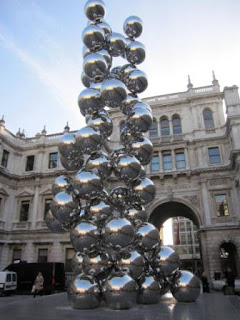Monday, 14 December 2009
The spectacular Stuart Haygarth at Haunch of Venison
Thursday, 10 December 2009
Pop Life at Tate Modern - Risqué Business
My highlights were Warhol's Gem's, Takashi Murakami's video with Kirsten Dunst with the soundtrack 'The Vapors - Turning Japanese', Damien Hirst's spot paintings with twins ('Ingo, Torsen' 1992, a set of identical twins stationed in front of two of Hirst's dot paintings), Gavin Turk's plaque (I never seem to tire of seeing this - probably because of the story which goes behind it) and Keith Haring's floor to ceiling embellished Pop Shop.
This is what artist/critic Matthew Collings had to say "What I thought after I came out of 'Pop Life'".
Wednesday, 9 December 2009
Exhibition Round Up - Kapoor, Kidner, GSK Contemporary and Hirst

The Kapoor exhibition is quite a spectacular and I think I probably did as much people watching as I did art viewing. I couldn't help but compare the experience at times to 'Waiting for Godot', the play by Samuel Beckett. Not just for the many ways of interpreting Kapoor's work like Beckett's play but also for the waiting element of the canon firing the red wax and the large slabs of red wax being pushed through the arches of the gallery, over and over but ever so slowly. During these moments of waiting there was time to contemplate the art - actually quite a clever strategy by Kapoor, as all too often we whizz round the galleries. These pieces enforced a waiting and contemplating, the artist imposing to an extent the time we spend with the work. In addition, strangers struck up conversation and shared the experience. Again this does not normally happen at galleries. A hush fell over the crowds when a gallery assistant came out to load the canon then the silence was interrupted with a loud bang and a huge cheer erupted as the mass of red wax splodge successfully onto the centre of the wall opposite; to start its slippery slow journey into the sea of red wax seeping over the floor of the Small Weston Room and then oozing out through the door frame onto the floor of the Large Weston Room
While I was at the Royal Academy I took the opportunity to see Wild Thing: Epstein, Gaudier-Brzeska, Gill, GSK Contemporary, Michael Kidner and then Damien Hirst at the nearby White Cube.
To sum up the others....
Wild Thing - good to see Epstein's Rock Drill and discovered Gaudier-Brzeska (who died in the first world war at the age of 23 and despite only 4 years developing his art was influential in its development in the 20th century).
GSK Contemporary - was poetic and thought provoking. with the work of Sophie Calle, Cornelia Parker, Darren Almond, Yao Lu, Antony Gormley, Clare Twomey, Ackroyd & Harvey and Lemn Sissay particularly standing out.
Michael Kidner - I was really disappointed that the catalogue had been sold out because I like his subject matter and approach to art. The Royal Academy's website says the following "A pioneer of Optical Art, Michael Kidner RA has devoted much of his career to developing work of a constructive nature. His interest in mathematics, science and theories of chaos has determined an art that is both formal and playful. The curiosity of his mind is matched by his willingness to accept the unexpected outcome." In particular the use of mathematics, science and philosophy to inform work which is both formal and playful resonates with me.
Okay...now onto Damien Hirst. He is one of the most talked about artists of our time and one of the most interesting. He also does get his fair share of criticism. I really tried to view the work with an open mind even leaning towards the positive - hoping to link them - to rebel against his critics. Unfortunately, I found them to be very poor pastiches of Frances Bacon right down to the lines, the gold frames, the scale and the proliferation of triptychs. Hirst's application of paint, his 'daubing', was, however, different to Bacon, albeit inferior.
